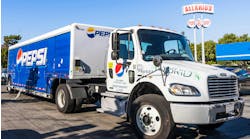A new report prepared by the National Research Council (NRC) for issuance by the National Highway Traffic Safety Administration (NHTSA) per Congressional mandate recommends how to improve the fuel economy performance of medium- and heavy-duty commercial vehicles. Back in 2007, Congress passed legislation requiring the Dept. of Transportation for the first time in history to establish fuel economy standards for medium- and heavy-duty vehicles, including everything from tractor-trailers to work trucks.
Released yesterday, Technologies and Approaches to Reducing the Fuel Consumption of Medium- and Heavy-Duty Vehicles also recommends approaches that federal agencies could take to regulate the fuel consumption of these vehicles. Currently there are no fuel consumption standards for such commercial vehicles, which NRC said account for about 26% of the transportation fuel used in the U.S.
“The choices that will be made over the course of the next few years will establish the regulatory design for medium- and heavy-duty vehicle fuel consumption standards for the next several decades,” said Andrew Brown Jr., chair of the committee that wrote the report, and executive director & chief technologist for Delphi Corp.
Brown’s committee estimates the improvements that various technologies could achieve over the next decade in seven vehicle types, including:
- Using advanced diesel engines in tractor-trailers could lower their fuel consumption by up to 20% by 2020
- Hybrid powertrains could lower the fuel consumption of vehicles that stop frequently, such as garbage trucks and transit buses, by as much 35% in the same time frame
- Improved aerodynamics could yield an 11% reduction in fuel consumption
Although the cost of making these improvements would be passed on to vehicle purchasers, the report’s authors claim that “many of these suites of technologies would pay for themselves even at today’s energy prices.”
The report also estimates the costs and maximum fuel savings that could be achieved for each type of vehicle by 2020 if a combination of technologies were used.
The authors said the best cost-benefit ratio was offered by tractor-trailers - as fuel use could be cut by about 50% for a savings of about $84,600 per truck. The improvements needed to do that would be cost-effective over 10 years provided gas prices are at least $1.10/gal.
For other vehicle classes, the financial investments in making improvements would be cost-effective at higher prices of fuel, the authors noted.
In setting fuel consumption standards, regulators should use a measure that accounts for the amount of freight carried, said the authors. In their view, any regulation of medium- and heavy-duty vehicles should “use a metric that reflects the efficiency with which a vehicle moves goods or passengers, such as gallons per ton-mile, a unit that reflects the amount of fuel a vehicle would use to carry a ton of goods one mile. This is called load-specific fuel consumption (LSFC).”
However, the report does not recommend a specific numerical standard “because NHTSA will need to establish standards tied to the task associated with a particular type of vehicle; garbage trucks might be held to a different standard than transit buses, for example.”
In addition, it was recommended that NHTSA should regulate “final-stage vehicle manufacturers” rather than component makers as the former has the greatest control over the vehicle's design. "Our committee also recommends that NHTSA conduct a pilot program to 'test drive' the certification process and validate the regulatory framework," said Brown.
While regulating the fuel economy of medium- and heavy-duty vehicles will be more complicated than it is for passenger cars, the authors argued that the “barriers are not insurmountable,” pointing out that Japan regulates the fuel economy of these vehicles and both the European Union and the State of California are developing standards.
“The American Trucking Assns. (ATA) appreciates the Council’s comprehensive assessment,” said ATA vp Glen Kedzie in a prepared statement about the report. “We look forward to continuing our work with both NHTSA and Environmental Protection Agency to further increase efficiencies within our industry and reduce greenhouse gas emissions through affordable technologies that achieve verifiable results.”
However, Allen Schaeffer, executive director of the Diesel Technology Forum, expressed to FleetOwner his view that it may not be easy to gain the levels of fuel economy the report appears to suggest. And this approach may be setting up conflicting priorities. “We’ve spent the last two decades controlling particulate matter and NOx [oxides of nitrogen] emissions in trucking, which led to reductions in fuel economy,” said Schaeffer earlier this year. “Now, we’re looking to control greenhouse gas emission [GHGs] and requiring improvements in fuel economy. If we’d started with this goal first, we wouldn’t have done what we did over the last 20 years.”
On the other hand, the report does state that one way “to avoid the complexity of regulating different vehicle types” would be to impose a fuel tax, “which would induce firms to optimize the fuel-efficiency of their operations.” The authors urged Congress to consider this approach.
Another alternative approach - applying a cap-and-trade system to trucking companies similar to the one that Congress is considering as a way to lower CO2 emissions – “would similarly provide these companies with an incentive to adopt fuel-saving technologies and operational methods,” the authors stated.
The report also recommends “nontechnical methods” NHTSA could use to lower fuel consumption, including incentives to train vehicle operators in efficient driving techniques. One method noted was to establish “a process to train and certify drivers in these techniques as part of commercial driver license certification.”


